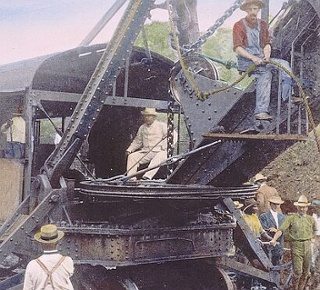Now how’s that for an idea?
Some plastic bottles are recyclable; other aren’t. What an American company, ByFusion, has come up with is this idea of mangling up the non-recyclable ones and sticking the bits together to make construction blocks similar to the concrete blocks in use at present. They can then be used to build a wall.
The plant they have designed will fit on the back of an articulated wagon and into a container. Their video does state, and I’m sure we’ll all agree, that plastic bottles come to litter up our construction sites because people are too lazy to throw them in the recycling skip. There is an inference in the ByFusion advertising that enough bottles can be collected off the site to build walls. Don’t think so! Anyone going for this wold need to find a source of supply for their bottles, but I’m sure that the waste disposal outfits would be happy to play along. Apparently this non-recyclable plastic takes 500 years to degenerate naturally, so no problem there. That is far longer than the design life-span of any building we are sticking up today. For example, the UK’s Code for Sustainable Homes states that as being a mere 35 years.
We do have a global problem with CO2 emissions and I have read that the production of concrete and steel account for 60% of those emissions. If these plastic bottle building blocks can cut down concrete production they will obviously be very “Green” and of benefit to our environment. Good idea!
These plastic bottle building blocks do, unfortunately, have a couple of draw-backs. The first is that they can’t be stuck together; they have to be simply stacked one on top of the other. That means that they don’t make a structurally stable wall. That might change if, in the future, some way of sticking them together – a plastic equivalent of sand/cement mortar – is produced. The second draw-back is that they are only capable of taking very low weight loadings, until concrete blocks. That excludes them from being used for the main application of concrete blocks; load bearing walls.
Find here: 3D-Printed Synthetic Spider Webs: New Building Material?
That will still make them, though, suitable for internal non-load bearing walls. There they will be a substitute for studding walls which have frames of either timber or steel. Less steel means less CO2 emission and we are running short of trees for timber, so that is a positive in plastic bottles favour.
Another use could be for the external, non-load bearing leaf, of cavity walls in, for example, house building. They could also be used externally for things like dividing walls between properties; walls lining footpaths in Parks or keeping kids in their school playgrounds. These plastic bottle blocks are, apparently, subject to ultra-violet degeneration. That means, when used externally, they have to be rendered to keep the sunlight off them. That wouldn’t be detrimental if they are inside a house but I’m sure the kids would feel deprived at not being able to see the colours and textures of them!
So are recycled plastic bottles going to be the next Green construction material? I think that will come down to one single factor that the manufacturers of the plant, ByFusion, aren’t telling us. Price! They will have to end up being cheaper to use than concrete blocks if the construction industry decides to use them in any quantity.




